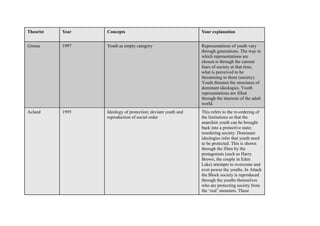
Theorists (x9)
- 1. Theorist Year Concepts Your explanation Giroux 1997 Youth as empty category Representations of youth vary through generations. The way in which representations are chosen is through the current fears of society at that time, what is perceived to be threatening to them (society). Youth threaten the structures of dominant ideologies. Youth representations are filled through the interests of the adult world. Acland 1995 Ideology of protection; deviant youth and This refers to the re-ordering of reproduction of social order the limitations so that the anarchist youth can be brought back into a protective state; reordering society. Dominant ideologies infer that youth need to be protected. This is shown through the films by the protagonists (such as Harry Brown, the couple in Eden Lake) attempts to overcome and over power the youths. In Attack the Block society is reproduced through the youths themselves who are protecting society from the ‘real’ monsters. These
- 2. representations are used to show the deviant and ‘normal’ youths the results of the actions of anarchist’s youths, in order to keep them within the boundaries in which they can be protected. Gramsci 1971 (1929-1935) Cultural hegemony(Audience effects theory) In all the three films the equilibrium (Todorov) is disrupted and thus dominant ideologies are disrupted. These dominant ideologies have been created through cultural hegemony and we, have been positioned to accept them as the ‘norm’. Themes of all three films revolve around the lower classes disruption of dominant ideologies and the middle class fighting to keep order. The fears of the middle class (and their power structure) are the lower class and their power to disrupt their ideals Cohen 1972 Moral panic(Audience effects theory) Creating a threat for society and therefore a social panic that will allow attacks on that threat. A panic created by cultural hegemony in order to overcome threats on society. A way of creating fear with the aim to re-
- 3. order society. McRobbie 2004 Symbolic Violence Creating a symbolic narrative in order to guide and offer self- improvement to the misguided; helping to redefine their identity. Violence is a symbolic representation/code of the lower social class and the male lower social class. This again helps to create a defining boundary between the middle and lower class; ensuring the dominant ideology of the ruling class. Gerbner 1986 Cultivation Theory(Audience effects theory) The effects of mass media communication on society’s beliefs and attitudes. The more violence seen in films the more likely we are to believe in its existence. Harry Brown and Eden Lake would then make us believe that it is the lower class British youths that behave in this way and therefore develop negative and fearful attitudes about them. This ultimately creates moral panic, through symbolic violence and follows cultural hegemony.
- 4. 1920’s Hypodermic Theory/Magic Bullet(Audience This theory suggests that effects theory) audiences passively receive the information transmitted via a media text, without any attempt on their part to process or challenge the data; so we can ultimately be easily manipulated (similar model to that of propaganda). It does not recognise that as consumers we have more control over how the media influences us. Copy Cat (Audience effects theory) Refers to the how the media influence and affects the audience behaviour and how they think. It relates to something publicized in the media that creates a lot of attention, causing other people to imitate in order to gain the same level attention. The well- known example of this is copycat murders, suicides and other violent acts that come with no other motive other than attention, caused by seeing the
- 5. same acts in the media, be it film, television or books. Stuart Hall 1980 Encoding – Decoding Theory (Audience Stuart Hall suggests that the reception theory) audience does not simply passively accept a text. There are, in his views, three ways in which audiences can read or decode and understand a text: 1) Preferred Reading/Dominant Hegemonic - when an audience interprets the message as it was meant to be understood, they are operating in the dominant code. The producers and the audience are in harmony 2) Negotiated Reading - Not all audiences may understand what media producers take for granted. There may be some acknowledgement of differences in understanding.
- 6. Audiences will understand the over- riding dominant ideologies within the text but they may not agree with all the views/ideas; audiences will make their own ground rules to get to the agreed dominant ideology (they will take a different path). 3) Oppositional Reading/'counter- hegemonic' – when an audience understands the context of the media text but they will decode the text in a completely different way; opposing the encoded text.
